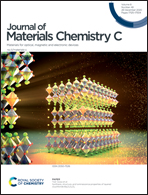Controllable magnetism driven by carrier confinement and ferroelectric polarization in a two-dimensional heterostructure†
Abstract
The coupling between ferroelectric and magnetic orders in multiferroic materials is significant for both fundamental science and technological applications. However, it has been a major challenge to discover and design two-dimensional multiferroic materials with large electric polarization and magnetoelectric coupling. Here, we propose a strategy to realize electric control of magnetism by constructing a new class of two-dimensional van der Waals heterostructures CuInP2S6/InSe based on monolayer ferroelectric CuInP2S6 and monolayer InSe. We find that at a small hole doping concentration, different magnetic states can be realized by controlling the polarization direction of the ferroelectric CuInP2S6. The physical origin of this purely electric-controlled magnetism can be well understood by considering carrier confinement effects and the Stoner mechanism. The predicted magnetoelectric coupling not only enriches our understanding of the coupling between ferroelectric and magnetic orders in ferroelectric heterostructures, but also has important significance for potential magnetoelectric device applications.



 Please wait while we load your content...
Please wait while we load your content...